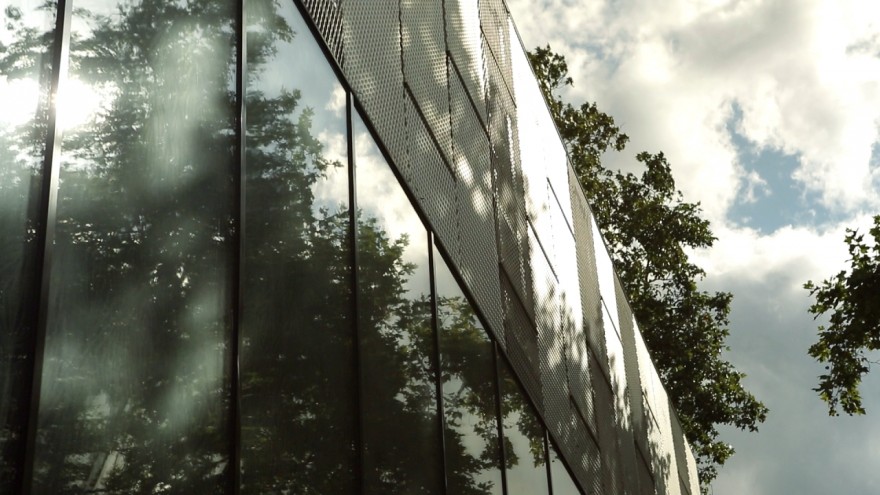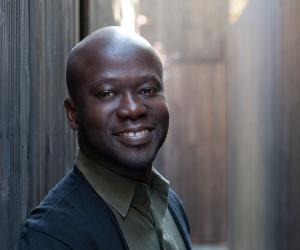From the Series
The documentary David Adjaye - Collaborations is a portrait of the architect through the eyes of others. The film features interviews with Adjaye's clients, commissioners and collaborators – a roster of influential figures in the art and cultural world. They include Peter Adjaye, Peter Allison, Okwui Enwezor, Thelma Golden, Julie Mehretu, Chris Ofili, Zoë Ryan, Taiye Selasi, Lorna Simpson, Deyan Sudjic and Sue Webster.
The film was written, directed and produced by Oliver Hardt of Signature Films in Frankfurt. Hardt focusses on films dedicated to design, arts and culture. His internationally acclaimed documentaries include This Building Will Sing for All of Us, his first film about Adjaye's work – specifically for the Smithsonian National Museum of African American History and Culture in Washington, D.C. – and The United States of Hoodoo.
Collaborations was commissioned by the Haus der Kunst in Munich and The Art Institute of Chicago as part of the exhibition David Adjaye: Form, Heft, Material curated by Okwui Enwezor and Zoë Ryan. It takes the audience inside a significant number of Adjaye's architectural projects, including the homes of Lorna Simpson and James Casabere, and Tim Noble and Sue Webster; as well as the Steven Lawrence Centre, the Idea Stores, Rivington Place, Bernie Grant Arts Centre, the Smithsonian National Museum of African American History and Culture, Gwangju River Reading Room, Sugar Hill Apartment Building; and the exhibition spaces “Liminal Squared” for Julie Mehretu and “The Upper Room” for Chris Ofili.
Why is the film called Collaborations?
I think David’s ability to work in collaboration with others is a defining characteristic of his practice. A big part of the film focusses on collaborative projects – for example, the Stephen Lawrence Center in London with Chris Ofili’s large-scale artwork on the glass facade; the wooden pavilion for the Gwangju Biennale in Korea that David collaborated on with novelist Taiye Selasi; or the homes and studios of Lorna Simpson and James Casebere and Tim Noble and Sue Webster.
But the title also refers to a more general aspect of David’s approach: the empathetic understanding of his clients’ needs and the thorough exchange that eventually turns them into collaborators. Over the course of time, during reseach and development, we added new aspects and perspectives – such as the more curatorial approach by Okwui Enwezor, Zoe Ryan and Thelma Golden, and some very concise insights from one of David’s long-term mentors, the researcher, editor and critic Peter Allison.
This is the second film you’ve made about David. What opportunities did doing a second one present? How is it different to the first film, This Building Will Sing For All Of Us?
My first encounter with David took place when I was researching a film about the new National Museum of African American History and Culture in Washington D.C.. The French-German culture channel arte had asked me to write a proposal for its programme on the 50th anniversary of the Great March on Washington and the Civil Rights movement. I wanted to focus on something that was contemporary and would open up new perspectives on this pivotal event, and I knew that David had not only been chosen as the designer for the new museum, but also that he has a deep interest in Africa and its diaspora.
In my work as documentary filmmaker I investigate how design, visual arts and architecture contribute to certain narratives. So I approached David because I wanted to develop the story from his point of view. Also, like him, I am very much interested in the creative, spiritual and political contribution of Africa and its diaspora to the world we are living in today. I believe that was a good starting point for This Building Will Sing For All Of Us, and I think that this successful first collaboration broke ground for the second film.
When I am working on a film I always have in mind the context of its primary mode of presentation. This can be theatrical, broadcast, or, in the case of Collaborations, an exhibition. So I chose a totally different approach for this film than for the first film, which was conceptualised for TV.
Collaborations works on different levels. For presentation at the exhibitions in Munich and Chicago it is organised into four self-contained parts that each highlight different aspects characteristic to David’s work. It is displayed in a spatial arrangement on four screens, each part on one screen. So you can choose whether you want to watch one part or two or all four. The feature-length edit, of course, works differently. Although it still does not have a linear or chronological structure, it illustrates and contextualises the evolving trajectory of David’s work from his earliest projects through to those that are yet to be realised.
And, last but not least, we decided to release excerpts from the film online. But instead of presenting the usual teasers or trailers, the web edition consists of an ongoing series of short, self-contained documentaries in which each episode is dedicated to one project or topic. All of this makes Collaborations a genuine multi-platform documentary that can be displayed in a multitude of contexts.
Can you tell us a bit about the process of research and shooting. How long did you work on this for? Where did it take you to in the world?
We began working on the project about a year before the recent premiere at Haus der Kunst in Munich. After an extensive period of research, we began filming in summer. My first interview was with Julie Mehretu in Berlin, an artist whose work I admire very much. London, New York and Munich were the other locations where we filmed interviews and buildings. I also used some footage of Washington D.C. from the previous film about the National Museum of African American History and Culture to enrich the narrative of Collaborations.
What was it like interviewing this incredibly diverse and top-notch roster of creatives?
After the premiere in Munich, someone approached me and said: “I know all these guys you feature in your film personally, and they are all themselves in it.” I think this is one of the biggest compliments I could get for my work...Oh my, these were such enjoyable encounters, indeed!
If you look at the roster of artists and curators, it’s hard to imagine them all in one film! And of course this was only possible because of David’s amazing ability to work with such a diverse group of clients and collaborators.
As a documentary filmmaker I always try to establish some kind of complicity with my counterpart. It takes a lot of research and preparation to reach the point during an interview where the interviewee starts to develop new thoughts – this becomes especially challenging when people are very experienced public speakers. I’m not sure whether I managed to get to that point with all of them, but I see a lot of these valuable moments in the film – and I like that very much. It wasn’t the first time I worked with artists and creatives of this calibre, but it never before felt so natural and intimate, both on a personal and intellectual level.
Which is your favorite building featured in the film and why?
This is a difficult question for me. I avoid choosing favourites while I am working on something. But in terms of which buildings picqued my curiosity to want to work on them further, I would pick two projects. The more obvious one of course is the museum in Washington, partly because I have already made a film about it in an early stage of its construction, and partly because it is such a pivotal moment both in David’s career and in the recognition of the contribution of African Americans to the history of the United States.
Next to that, what really caught my interest is the Sugar Hill apartment building. It combines a lot of things that are exciting for me as a filmmaker with a focus on arts and culture: the building is highly controversial with regard to its design and appearance; and it stands in a neigbourhood that is incredibly rich with cultural history (and I am not only talking about the commercial breakthrough of hip hop with the Sugar Hill Gang at the end of the 1970s).
From my point of view, the most exciting thing about the Sugar Hill building is the simple question: Will it work? Or, more precisely: How will it interact with its inhabitants who have just moved in? What makes living in it special; what makes it more than just another affordable housing project? How will David’s architecture – which is known for dissolving barriers, accommodating difference and embracing its users – be received by the families, the kids, the former homeless people? And how will its presence change the neighbourhood and the communities around there?
What does the film add to the exhibition that you can’t get from looking at the display?
I think one of the defining aspects of the film within the context of the exhibition is, as one reviewer says, that it enables the audience to appreciate how the built structures on display take on a life that both mirrors and shapes the people who inhabit it. What they definitely can learn from the film is that architecture is something vital, social, political – something that speaks to its dwellers and users, no matter whether this is an artist couple or a diverse community in a deprived part of London.






















